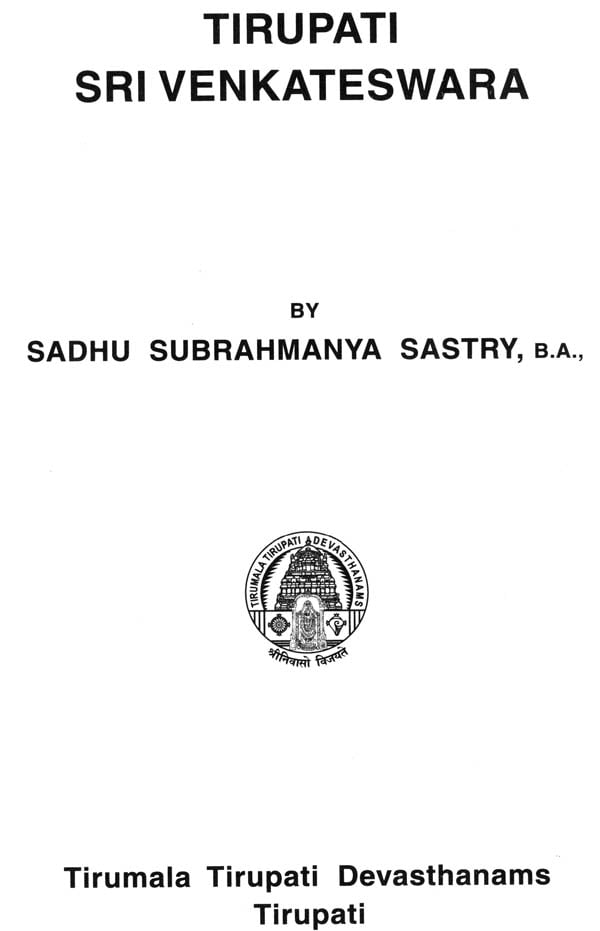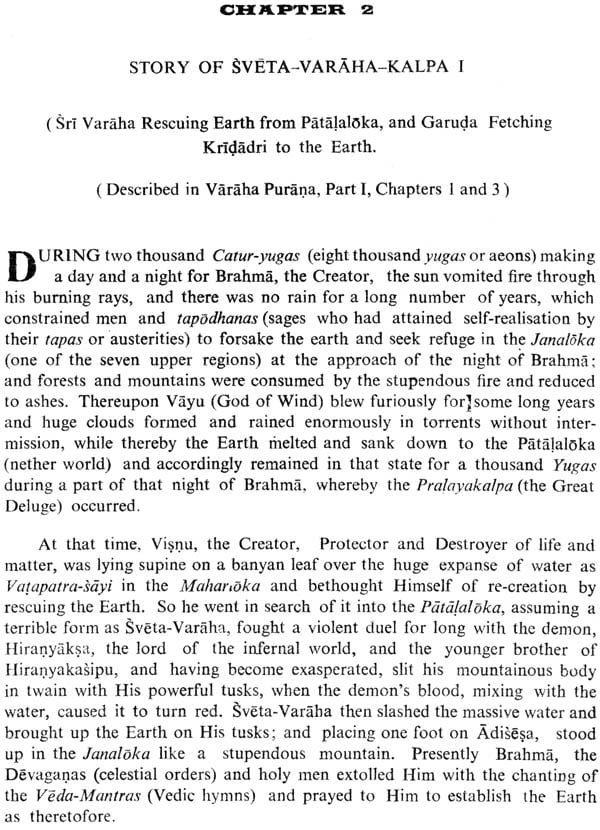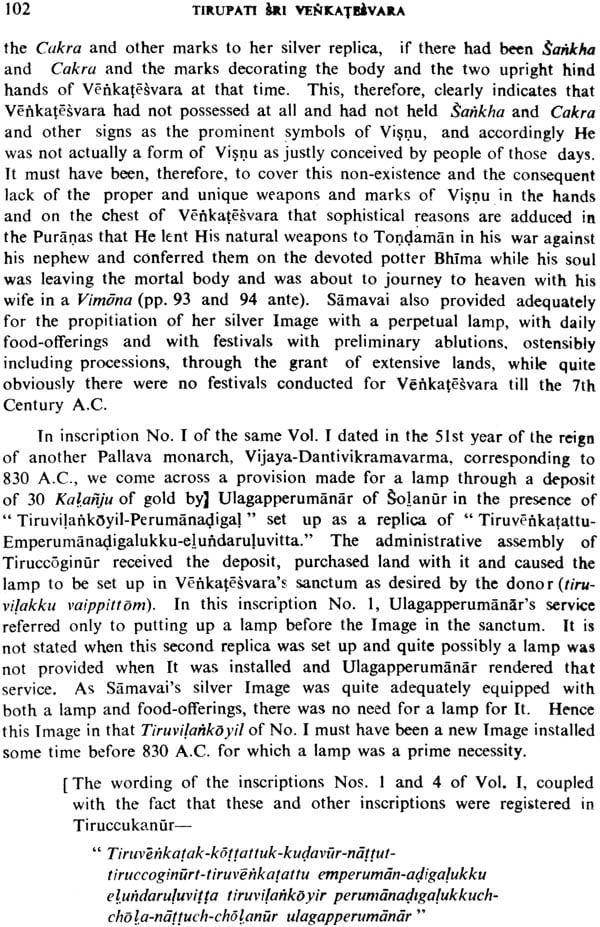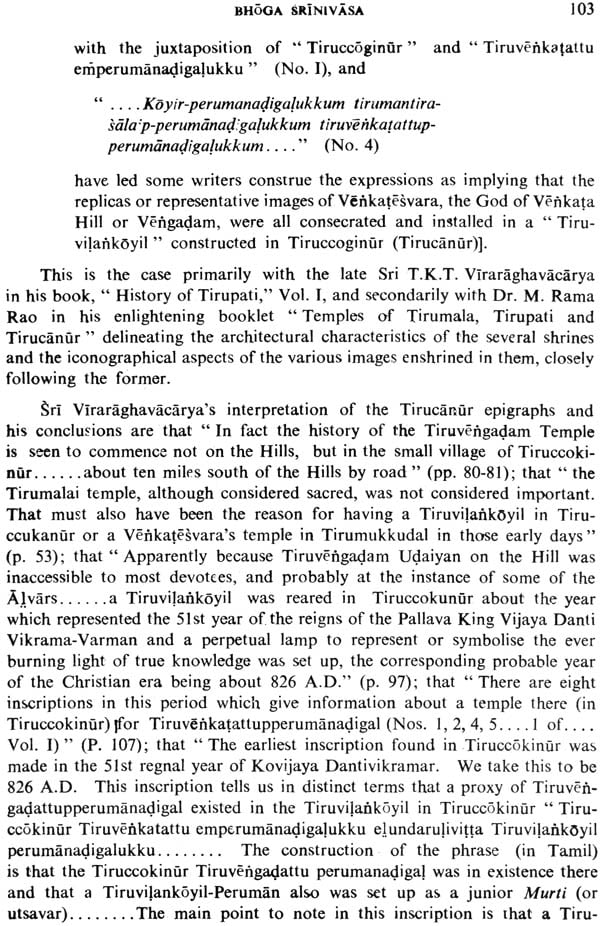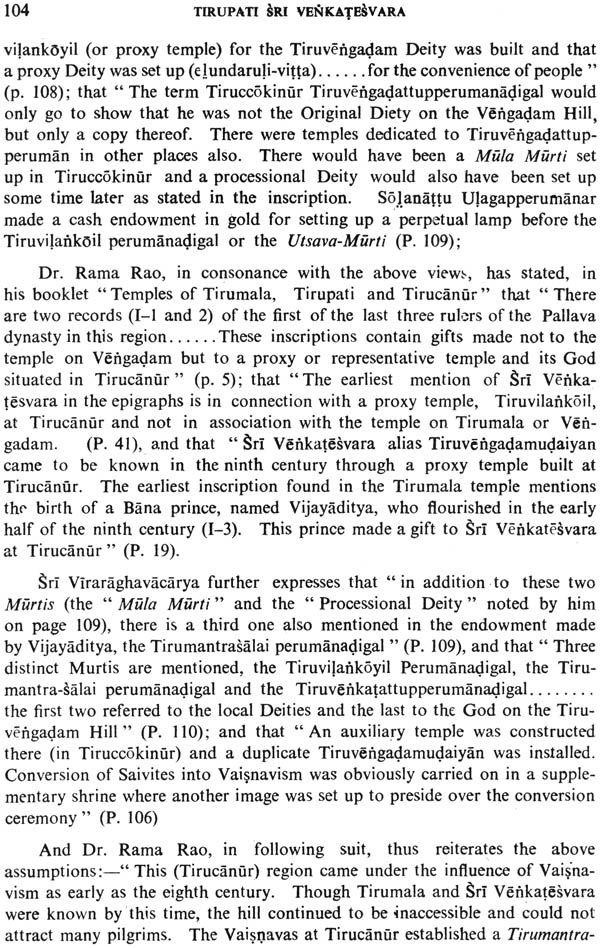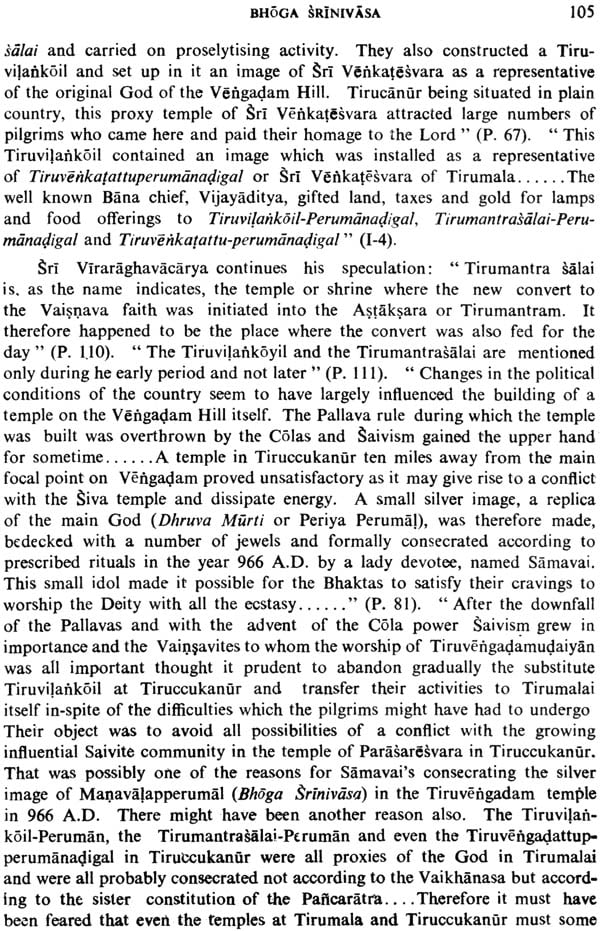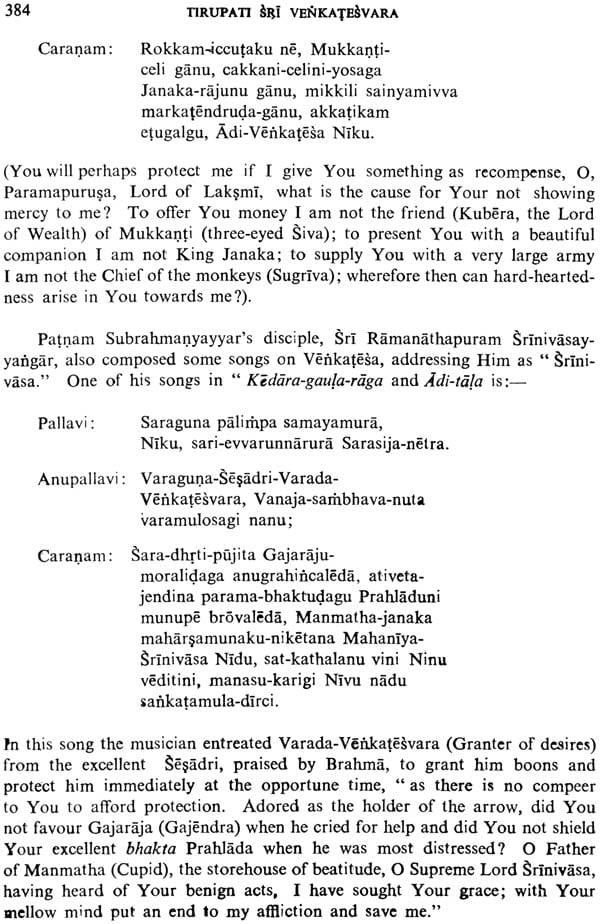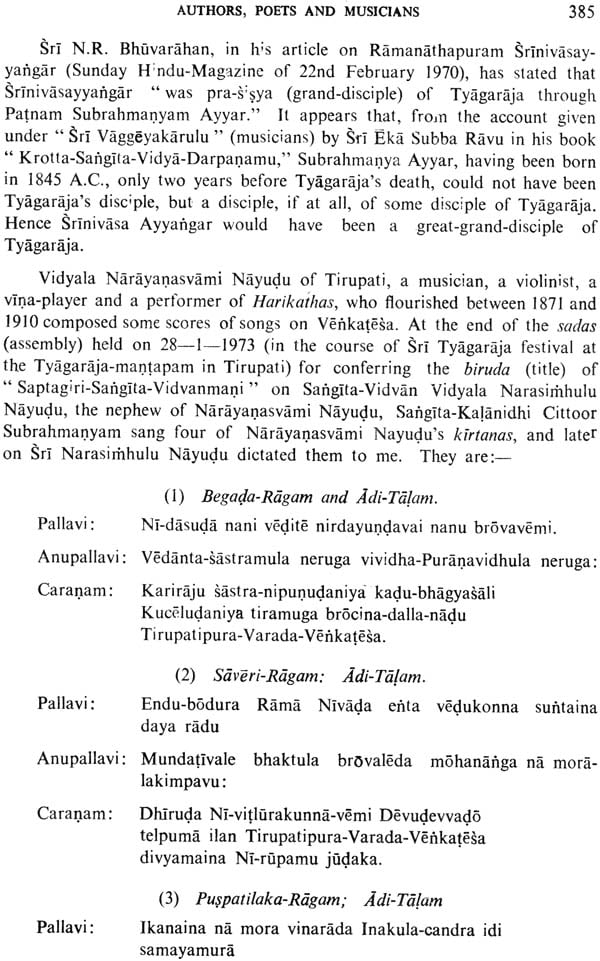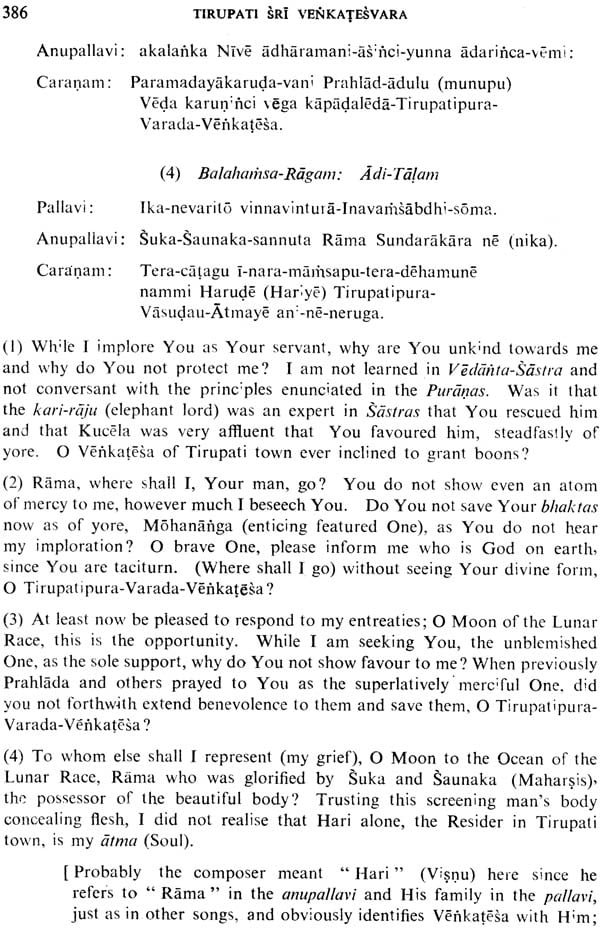
Tirupati Sri Venkateswara
Book Specification
| Item Code: | NAK692 |
| Author: | Sadhu Subramanya Sastry |
| Publisher: | Tirumala Tirupati Devasthanams, Tirupati |
| Language: | English |
| Edition: | 2014 |
| Pages: | 423 (10 B/W Illustrations) |
| Cover: | Hardcover |
| Other Details | 9.0 inch x 7.5 inch |
| Weight | 770 gm |
Book Description
Our sacred shrines have been the most prominent institutions down the centuries. They were the centres not only of religious but also educational, social and cultural activities of people. Thousands of inscriptions engraved on the temple walls throw light on the religious and social life of the people. It was neither the generous patronage of the rulers of this land nor the magnificence of the temple architecture, but the unwavering devotion of legions of men and women that had made our temples the impregnable fortresses of spiritual energy. The Deities consecrated in these places thus naturally became the eternal radiant presence in their lives and the abiding grace of these Divinities guided them along the righteous path. Among the great shrines dedicated to. Lord Sriman Narayana, the temple of Lord Venkateswara stands out as a visible symbol of our spiritual ethos and the Lord is enshrined in the hearts of millions of devotees in every part of India. Though the origin of the temple dates beyond the recorded history, the legend as well as the inscriptional evidence provides a wealth of information about the growth and development of the temple. The present book 'Tirupati Sri Venkateswara' written by the Devasthanams epigraphist the late Sri Sadhu Subrahmanya Sastry was first published by TTDs in 1981. The book provides a detailed account of the history and liturgical aspects of the temple, besides containing extracts from the Varaha and Bhavishyottara puranas. It also vividly describes the salient features of the temple architecture, administration of the temple during the period of great imperial powers and extensively deals with the lasting contributions of musicians, poets and authors who immortalised the glory of Lord Srinivasa through their sublime poesy. We are happy to present this reprint of 'Tirupati Sri Venkateswara' which is an indispensable book for every devotee of Lord Venkateswara.
PLUTARCH'S" Life of Julius Caesar" in its English translation by Sir Thomas North formed the source for Shakespeare's drama" Julius Caesar". Since it was not available to me, I read 'the translation of Plutarch by Rev. Longhorn in Cassell's" People's Books" series. It is therein narrated that, when Caesar was posted to Spain as quaester, while he was about 30 years of age, having been born in 103 B.C., he visited Cadiz, and in the temple of Hercules therein he saw the statue of Alexander which brought to his memory Alexander's extensive conquest of the then known world upto India and his death before he was 30 years old, and his universal fame. This thought induced a feeling of sorrow, in Caesar and he wept. His friends and companions looked at him with surprise, and he related to them, " Have I not a reason to weep? Alexander was not 30 years old while he conquered the whole world and died, leaving a great name behind him. I am passing my 30th year, and till now I have not done anything great to deserve a name. This consideration evoked sorrow in me and obliged me to shed tears".
My reading of this incident in Caesar's life provoked sorrow in me and tears trickled from my eyes, though I was not 30 years old at that time, since I could not conceive then whether I would have a chance to do anything note-worthy at all and in what line, in this mundane life without passing an unworthy life, whereas Caesar, though stricken with grief in his earlier days, however also attained in his later life equal universal fame with Alexander, through his daring military achievements. From that time onwards, whenever Caesar came to my thought, my mind sorrowed heavily and my eyes shed tears.
Poet Milton composed a sonnet" On My Twenty-third Year" on the occasion of the anniversary of his twenty-fourth birthday which occurred on 9th December 1632 A.C. In it he expressed his regret that, though" I to manhood am arrived so near", he did not appear as old as he actually was, that the spring-time of his life which he lately passed had not brought forth any fruit in the form of a standard literary work, as his mind, too, did not mature sufficiently, and that, therefore, he was not as fortunate as some of his contemporaries who were more happily" endued" with both" semblance", physical appearance, and mental" inward ripeness". But he preferred to wait till" that same lot, however mean or high, Toward which Time leads me ", in accordance with "the will of Heaven", befell him, and then' he wished to utilise that opportunity to the full, with God's grace, "As ever-in my great Task-Master's eye" he bad it, as he believed.
Though he thus resolved to bide his time, Milton was anxious to write on some theme, "Things unattempted yet in prose or rhyme", and" to soar above the Aonian mount". He tried his hand on a few subjects, and then proceeded to some length on the story of King Arthur and the Knights of His Round Table. This theme involving romances of the Knights, was distasteful to him as an ardent Puritan, was given up by him; and ultimately he chose the Biblical subject of the "Paradise Lost" and pleasingly completed it exquisitely and achieved his object.
These events in the lives of these two great men stimulated my mind and instilled in me the desire and eagerness to do something substantial and note-worthy; but as I could not know my future in this respect, my desire only lay dormant in my mind.
In May 1919 I was drafted into the Tirumala-Tirupati Devasthanams service by its Vicharanakarta, Sri Mahant Prayagadasaji, and was thereby afforded an opportunity to serve Sri Venkatesvarasvami for over 25 years with devotion, faith, zeal and uprightness in various administrative capacities.
In 1921 Sri H. Krishna Sastry, the Government Epigraphist, along with Dr. F. W. Thomas of the India Office Library, London, visited Tirumala. Sri Mahant instructed the Diwan Peshkar of the Devasthanams, Sri C. Doraswamiah, B.A., B.L., to meet Sri Krishna Sastry and request him to depute a member -of the Epigraphical staff to copy the inscriptions engraved on the Prakara walls of the temples in Tirumala and Tirupati to be enabled to know the history of Sri Venkatesvarasvami and Sri Govindarajasvami enshrined in them. On Sri Doraswarniah's request. Sri Krishna Sastry told him that he would move the matter with the Assistant Archaeological Superintendent for Epigraphy at Madras, ascertain his view and communicate it to Sri Mahant. He consulted the Epigraphical Superintendent who informed him that his staff was too inadequate to cope with its own work within its extensive jurisdiction throughout South India and that, therefore, he could not spare anyone of his staff for the Tirupati Devasthanam's work, and suggested that if the Devasthanams' selected a suitable candidate and deputed him to his office, he would be given training for about six months and that threafter he could carryon the Devasthanam's epigraphical work independently. Sri Krishna Sastry informed Sri Mahant of this suggestion. On receipt of this communication, Sri Mahant and Sri Doraswamiah consulted together, but could not pitch upon anyone of the staff in the Devasthanam Office for deputation for epigraphical training. At that time I was the Personal Assistant to Sri Mahant, and I was present at their consultation. In the end Sri Doraswamiah proposed me and Sri Mahant asked me if I would agree to go for training. Without any hesitation and quite readily I consented, since the sorrows of Julius Caesar and Milton ever haunted my mind and my dormant desire was then aroused, as it appeared to provide an unique opportunity to me to carryon a valuable and specially scholarly work which would fall to my lot. Both of them were pleased and my name was communicated to the Epigraphical Superintendent at Madras. He sought orders from the Government of Madras for my training in his office; and the Madras Government issued G. O. No. 610 (Finance), dated the 14th June 1921, permitting my training. There upon I joined the Madras Epigraphical Office located in Kilpauk at that time in August 1921. I accompained some members of its staff for observing practical field work to Tanjore. Tiruchirapalli, Madura, Dendulur, Ellore, Vijayawada, Nellore , Srikalahasti and other places. I returned to the Tirupati Devasthanam in February 1922.
Thereafter, I started the work by copying inscriptions from the walls of Sri Venkateswara's and Sri Govindaraja's temples, and carried it on with the estimable assistance of the experienced and capable, Pandit V. Vijayaraghava Charya. Also Sri R. Krishna Rao, B.A.,L.T., a teacher of the Tirupati Devasthanam High School, ably assisted me for nearly two years.
Along with this work of copying epigraphs, I transported the sankirtana copper plates of the Tallapakam musician-poets, Annamacharya, his son Pedda-Tirumalacharya, and this latter's son Chinna-Tirumalacharya, preserved in a cell in Sri Venkatesvara's temple, to the Tirupati Office and had them transcribed on paper and preserved these transcripts in three teak-wood boxes. From them I selected their" Minor Works" into a volume, and some" Adhyatma Sankirtanas" and "Sringara Sankirtanas" into two separate volumes. At my request, Sri Kalabari Venkataramana Kavi, Telugu Pandit of the Devasthanam High School, Tirupatti, contributed foot-notes to them. After some time these three volumes were published, with the omission of much of the foot-notes, by the Devasthanam Press.
| Chapter No. | Page No. | |
| 1 | Preamble | 1 |
| 2 | Story of Sveta- Varaha- Kalpa-I | 3 |
| 3 | Varaha's residence on the Venkatadri and consequent worth of the Hill | 6 |
| 4 | Different names given to Kridadri during different Yugas | 9 |
| 5 | Mahatmya of Sri Svami Puskarini and other Tirthas | 13 |
| 6 | Visnu's resort to Venkatadri (Bhavisyottara Purana, Chapter-2 | 27 |
| 7 | Brahma, Devas and Rsis seeing Visnu on the Venkatadri- Dasaratha also proceeding there then | 33 |
| 8 | Inauguration of Brahmotsva for Sri Visnu-Venkatesvara by Brahma | 43 |
| 9 | Settlement of Visnu as Venkatesvara on the Venkatacala and his occasional revelation | 51 |
| 10 | Akasaraja born as the son of Mitravarma | 64 |
| 11 | Visit of the Rsis (Munis) from the Naimisaranya to the Venkatadri | 74 |
| 12 | Sri Venkatesvara's temple on the Venkatacala | 76 |
| 13 | Venkatesvara in his illustratious sanctum under the grand gilded Vimana | 92 |
| 14 | Laudation of Sri Venkatesvara by Vaisnava Alvars | 113 |
| 15 | Royal Benefactions and Laity's services to Sri Venkatesvara | 142 |
| 16 | Fulfilment of Temple needs | 162 |
| 17 | Period of the First Vijayanagara dynasty | 170 |
| 18 | Period of Saluva Narasimha's regime | 182 |
| 19 | Emperor Krsnadevaraya's time | 210 |
| 20 | Emperor Acyutaraya's time | 234 |
| 21 | Emperor Sadasivarayas time | 254 |
| 22 | Aravidu dynasty rulers and subsequent Period | 275 |
| 23 | Ruin overtaking the Vijayanagara empire | 287 |
| 24 | Acquisition and Administration of Venkatesvara's temple by the English East India Company | 305 |
| 25 | Relinquishment of Temple administration by the British through its transfer to Mahants leading to prosperity | 336 |
| 26 | Dedications and Eulogies of Authors , Poets and Musicians | 343 |
| Sri Venkatesa Suprabhatam (Short notes) | 396 | |
| Sri Venkatesa- Astottora- Sata- Namah | 398 |
